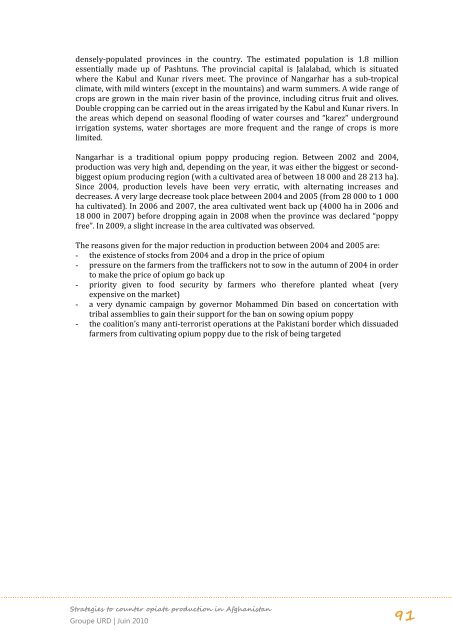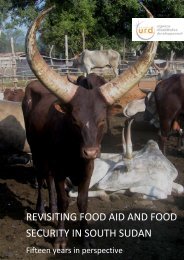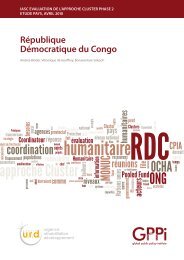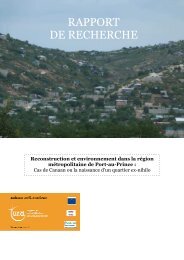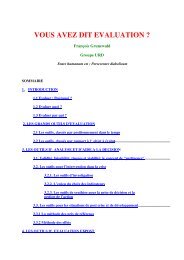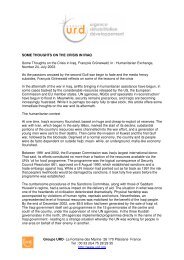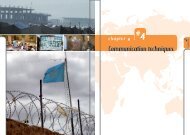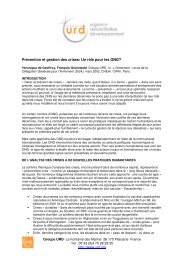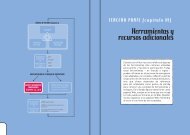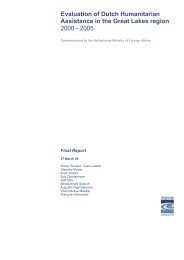strategies to counter opiate in Afghanistan - Groupe URD
strategies to counter opiate in Afghanistan - Groupe URD
strategies to counter opiate in Afghanistan - Groupe URD
Create successful ePaper yourself
Turn your PDF publications into a flip-book with our unique Google optimized e-Paper software.
densely-populated prov<strong>in</strong>ces <strong>in</strong> the country. The estimated population is 1.8 million<br />
essentially made up of Pashtuns. The prov<strong>in</strong>cial capital is Jalalabad, which is situated<br />
where the Kabul and Kunar rivers meet. The prov<strong>in</strong>ce of Nangarhar has a sub-tropical<br />
climate, with mild w<strong>in</strong>ters (except <strong>in</strong> the mounta<strong>in</strong>s) and warm summers. A wide range of<br />
crops are grown <strong>in</strong> the ma<strong>in</strong> river bas<strong>in</strong> of the prov<strong>in</strong>ce, <strong>in</strong>clud<strong>in</strong>g citrus fruit and olives.<br />
Double cropp<strong>in</strong>g can be carried out <strong>in</strong> the areas irrigated by the Kabul and Kunar rivers. In<br />
the areas which depend on seasonal flood<strong>in</strong>g of water courses and “karez” underground<br />
irrigation systems, water shortages are more frequent and the range of crops is more<br />
limited.<br />
Nangarhar is a traditional opium poppy produc<strong>in</strong>g region. Between 2002 and 2004,<br />
production was very high and, depend<strong>in</strong>g on the year, it was either the biggest or secondbiggest<br />
opium produc<strong>in</strong>g region (with a cultivated area of between 18 000 and 28 213 ha).<br />
S<strong>in</strong>ce 2004, production levels have been very erratic, with alternat<strong>in</strong>g <strong>in</strong>creases and<br />
decreases. A very large decrease <strong>to</strong>ok place between 2004 and 2005 (from 28 000 <strong>to</strong> 1 000<br />
ha cultivated). In 2006 and 2007, the area cultivated went back up (4000 ha <strong>in</strong> 2006 and<br />
18 000 <strong>in</strong> 2007) before dropp<strong>in</strong>g aga<strong>in</strong> <strong>in</strong> 2008 when the prov<strong>in</strong>ce was declared “poppy<br />
free”. In 2009, a slight <strong>in</strong>crease <strong>in</strong> the area cultivated was observed.<br />
The reasons given for the major reduction <strong>in</strong> production between 2004 and 2005 are:<br />
- the existence of s<strong>to</strong>cks from 2004 and a drop <strong>in</strong> the price of opium<br />
- pressure on the farmers from the traffickers not <strong>to</strong> sow <strong>in</strong> the autumn of 2004 <strong>in</strong> order<br />
<strong>to</strong> make the price of opium go back up<br />
- priority given <strong>to</strong> food security by farmers who therefore planted wheat (very<br />
expensive on the market)<br />
- a very dynamic campaign by governor Mohammed D<strong>in</strong> based on concertation with<br />
tribal assemblies <strong>to</strong> ga<strong>in</strong> their support for the ban on sow<strong>in</strong>g opium poppy<br />
- the coalition’s many anti-terrorist operations at the Pakistani border which dissuaded<br />
farmers from cultivat<strong>in</strong>g opium poppy due <strong>to</strong> the risk of be<strong>in</strong>g targeted<br />
Strategies <strong>to</strong> <strong>counter</strong> <strong>opiate</strong> production <strong>in</strong> <strong>Afghanistan</strong><br />
<strong>Groupe</strong> <strong>URD</strong> | Ju<strong>in</strong> 2010<br />
91


